It thus seems possible that the Pleiades
year in a way was equivalent to the year of Vega.
726 (December 27 when the Sun was at the
right ascension line at Vega) + 58 (= 2 *
29 → 229) = 784 = 365 + 365 + 54 (Terminalia,
February 23):
|
TERMINALIA |
|
 |
|
Gb8-5 (446) |
|
April 28 (118) |
|
TOLIMAN (*221) |
In order to keep track of the positions of
the fixed stars in the night a 'line of
fire' at the horizon in the east should be
drawn down from the star at the pole. At spring
equinox this line corresponded to where in
the morning the Sun rose up at dawn. At
midsummer the line had shifted ahead to
noon, etc. When the Earth moved around the
Sun the heliacal direction to some specific star
would change correspondingly.
In midwinter the right ascension line for
star observations could therefore be expected to
be at midnight.
|
dawn |
noon |
sundown |
midnight |
|
equinox |
midsummer |
equinox |
midwinter |
|
0h |
6h |
12h |
18h |
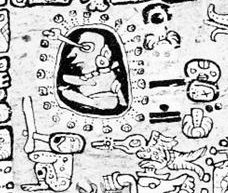
... A Scorpion-Man plays
also another part in the cosmology of the
Babylonians. The Scorpion-Man and his wife
guard the gate leading to the Maśu
mountain(s), and watch the sun at rising and
setting. Their upper part reaches to the
sky, and their irtu (breast?) to the
lower regions (Epic of Gistubar 60,9). After
Gistubar has traversed the Maśu Mountain, he
reaches the sea. This sea lies to the east
or south-east.
However obscure these conceptions may be,
and however they may render a general idea
impossible, one thing is clear, that the
Scorpion-Men are to be imagined at the
boundary between land and sea, upper and
lower world, and in such a way that the
upper or human portion belongs to the upper
region, and the lower, the Scorpion body, to
the lower. Hence the Scorpion-Man represents
the boundary between light and darkness,
between the firm land and the water region
of the world.
Marduk,
the god of light, and vanquisher of
Tiamat, i.e. the ocean, has for a symbol
the Bull = Taurus, into which he entered in
spring.
.jpg)
This leads almost
necessarily to the supposition that both the
Bull and the Scorpion were located in the
heavens at a time when the sun had its
vernal equinox in Taurus and its autumnal
equinox in Scorpio, and that in their
principal parts or most conspicuous star
groups; hence probably in the vicinity of
Alderbaran and Antares, or at an epoch when
the principal parts of Taurus and Scorpio
appeared before the sun at the equinoxes.
[Cited from Jensen in his 'Kosmologie der
Babylonier']
If my suggestion be
admitted that the Babylonians dealt not with
the daily fight but the yearly fight between
light and darkness - that is, the antithesis
between day and night was expanded into the
antithesis between the summer and the winter
halves of the year - then it is clear that
at the vernal equinox Scorpio setting in the
west would be watching the sunrise; at the
autumnal equinox rising in the east, it
would be watching the sunset; one part would
be visible in the sky, the other would be
below the horizon in the celestial waters.
If this be so, all obscurity disappears, and
we have merely a very beautiful statement of
a fact, from which we learn that the time to
which the fact applied was about 3000 B.C.,
if the sun were then near the Pleiades
...
In the Mesopotamian cylinder seal above we
can see how the Lion (the Sun) entered
into the reversed hide of the Bull, because
the precious vase was no longer vertical but
had changed its orientation to horizontal.
It was empty and dry.
The movement was towards the left. If the
Bull ruled during summer, then he should be
finished at sundown.

In the lower register the perceived movement was
continuing under the earth and now towards
the right (back to the origin), from X
marking the seat all the way to the top of
the earth mountain.

Although Vega had been at the pole about
26000 / 2 years ago it was easy to count
90 days from sundown to find its current
position. 271 + 90 = 361.
|
8 |
65 = 361 - 296 |
|
|
OCT 16 (289) |
5.0 |
OCT 21 (*214) |
2 |
Oct 24 ('217) |
6 |
OCT 31 (*224) |
NOV 1 (305) |
56 |
DEC 28 (362) |
|
 |
 |
 |
 |
 |
 |
|
Ga8-6 (209) |
Ga8-11 (214) |
Ga8-14 (217) |
Ga8-21 (224) |
Ga8-22 (225) |
Gb2-27 (282) |
|
18h (*273.4) |
ξ
Pavonis (*278.4) |
VEGA |
NUNKI (*288.4) |
τ
Sagittarii
|
*346 |
|
Dec 19 (353) |
X-MAS EVE (358) |
Dec 27 (19 * 19 = 361) |
Jan 3 (368) |
19h (*289.4) |
March 2 (61) |
|
73 = 361 - 288 |
|
365 - 361 = 4 and together with 181 (June
30) this was 185 days.
|
361 |
4 |
366 |
179 |
181 |
178 |
360 |
|
Dec 27 |
Jan 1 |
June 30 |
Dec 26 |
|
5 |
180 |
180 |
|
365 |
The primary cardinal point was the winter the
solstice.
Vega was 6 days
after the December solstice (355) and Sirius
was 6 days after Canopus (175), i.e. 175 +
180 = 355.
And when
watching the culmination right ascension
line of Vega at 21h (halfway from 18h to
24h) after which the Sun would rise in
August 13 (225 = 180 + 45), it could be
deduced that the right ascension line of
Sirius would be half a year away:
|
CLOSE TO THE FULL
MOON: |
|
DEC 7 (*261) |
8 |
9 (7 * 7 * 7) |
10 |
11 (345) |
12 (*266) |
 |
 |
 |
 |
 |
 |
|
Gb2-6 (9 * 29) |
Gb2-7 |
Gb2-8 |
Gb2-9 (35) |
Gb2-10 |
Gb2-11
(266) |
|
BUNDA (Foundation) / KAKKAB
NAMMAΧ (Star of Mighty Destiny) |
θ Piscis Austrini (330.1), λ
Oct. (330.7) |
|
Al Sa'd al Su'ud-22 (Luckiest of
the Lucky) /
Emptiness-11 (Rat)
TSIN = 36 Capricorni
(325.2),
ALPHIRK (The Flock) =
β
Cephei
(325.7),
SADALSUD =
β
Aquarii,
ξ
Gruis (325.9) |
No star listed (326) |
CASTRA = ε Capricorni
(327.2),
BUNDA = ξ Aquarii
(327.5)
SIRIUS (α Canis Majoris)
|
Mahar sha hi-na
Shahū-26 (Western One in the
Tail of the Goat)
NASHIRA
=
γ
Capricorni
(328.0),
ν
Oct. (328.3),
AZELFAFAGE
=
π¹
Cygni,
κ
Capricorni (328.7) |
Arkat sha hi-na
Shahū-27 (Eastern One in the
Tail of the Goat)
ENIF (The Nose) =
ε
Pegasi, ERAKIS =
μ
Cephei
(329.2),
46 CAPRICORNI,
JIH (the Sun) =
κ
Pegasi
(329.3),
ι
Piscis Austrini (329.4),
λ
Capricorni (329.6),
ν
Cephei (329.7),
DENEB ALGIEDI =
δ
Capricorni
(329.8)
*288.0 = *329.4 - *41.4 |
 |
|
Febr 9 (40) |
10 |
(343 + 64) |
(408 = 43 + 365) |
13 |
All Hearts' Day |
|
... On
February 9 the Chorti Ah K'in,
'diviners', begin the
agricultural year. Both the
260-day cycle and the solar year
are used in setting dates for
religious and agricultural
ceremonies, especially when
those rituals fall at the same
time in both calendars. The
ceremony begins when the
diviners go to a sacred spring
where they choose five stones
with the proper shape and color.
These stones will mark the five
positions of the sacred
cosmogram created by the ritual.
When the stones are brought back
to the ceremonial house, two
diviners start the ritual by
placing the stones on a table in
a careful pattern that
reproduces the schematic of the
universe. At the same time,
helpers under the table replace
last year's diagram with the new
one. They believe that by
placing the cosmic diagram under
the base of God at the center of
the world they demonstrate that
God dominates the universe. The
priests place the stones in a
very particular order. First the
stone that corresponds to the
sun in the eastern, sunrise
position of summer solstice is
set down; then the stone
corresponding to the western,
sunset position of the same
solstice. This is followed by
stones representing the western,
sunset position of the winter
solstice, then its eastern,
sunrise position. Together these
four stones form a square. They
sit at the four corners of the
square just as we saw in the
Creation story from the Classic
period and in the Popol Vuh.
Finally, the center stone is
placed to form the ancient
five-point sign modern
researchers called the quincunx
...

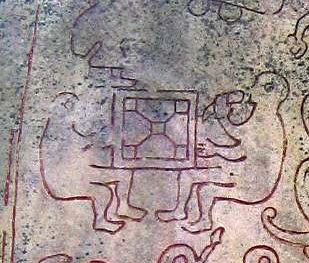
 |
|
°Febr 5 |
6 |
7 |
8 (*324) |
9 |
10 (41) |
|
'Jan 13 (378) |
14 |
15 (*300) |
16 |
17 |
18 (383) |
|
"Dec 30 |
31 |
"Jan 1 |
2 |
3 (368) |
4 |
|
CLOSE TO THE SUN: |
|
JUNE 7 (*78) |
8 |
9 |
10 (161) |
11 |
12 |
|
Fibonacci: 1, 1, 2, 3, 5, 8, 13,
21, 34, 55 ... → 1.618033998 ...
= φ = (1 + √5) / 2.

... The month, which takes its
name from Juppiter the oak-god,
begins on June 10th and ends of
July 7th. Midway comes St.
John's Day, June 24th, the day
on which the oak-king was
sacrificially burned alive. The
Celtic year was divided into two
halves with the second half
beginning in July, apparently
after a seven-day wake, or
funeral feast, in the oak-king's
honour
...
.jpg) |
|
The Knot (Ukdah) |
5 Imix 9 Kumk'u
Rishu A.-13 (Head of the Lion)
ψ Leonis (146.4),
RAS ELASET AUSTRALIS = ε Leonis
(146.6)
*105.0 = *146.4 - *41.4 |
VATHORZ PRIOR = υ Carinae
(147.9) |
|
Star-25 (Horse) /
ANA-HEU-HEU-PO-5 (Pillar where
debates were held)
ALPHARD (The Horse)
=
α
Hydrae
(142.3),
ω
Leonis (142.6),
τ¹
Hydrae (142.7) |
Al Tarf-7 (The End)
ψ
Velorum (143.3),
ALTERF =
λ
Leonis,
τ²
Hydrae (143.4),
ξ
Leonis (143.5)
*102.0 = *143.4 - *41.4 |
A Hydrae
(144.1)
VEGA (α Lyrae)
|
Creation of our present world
UKDAH (Knot) =
ι
Hydrae
(145.4),
κ
Hydrae (145.5),
SUBRA =
ο
Leonis
(145.8)
*104.0 = *145.4 - *41.4
ALPHEKKA MERIDIANA |
|
Aug 10 |
11 |
12 |
13 (*145) |
14 |
15 (227) |
|
°Aug 6 |
7 |
8 (220) |
9 |
10 |
11 (*143) |
|
'July 14 |
15 |
16 |
17 (*118) |
18 |
19 (200) |
|
"June 30 |
"July 1 |
2 |
3 (*104) |
4 |
5 (186) |
|
Itzam-Yeh defeated |
28
May (148), 3149 BC |
|
1st
3-stone place |
21
May (141), 3114 BC |
|
Creation of our
present world |
13
August (225), 3114
BC |
|
Och
ta chan (Hun-Nal-Ye
'entered or became
the sky') |
5
February (36), 3112
BC |
|
21
May, 3114 BC - 5
February, 3112 BC =
542 |
|
542
'happens to be' the
sum of 365 days and
6 * 29½ nights. |
.. In three
magnificent texts at the
site of Koba, scribes
recorded it as one of the
largest finite numbers we
humans have ever written.
According to these
inscriptions, our world was
created on the day 4 Ahaw
8 Kumk'u. On this day
all the cycles of the Maya
calendar above twenty years
were set at thirteen - that
is to say, the cycles of 400
years, 8,000 years, 160,000
years, 32,000,000 years, and
so on, all the way up to a
cycle number extending to
twenty places (2021
* 1360-day year).
In our
calendar, this day fell on
August 13, 3114 BC. To
understand what this means,
we need a little scale. The
thirteens in this huge
number act like the twelve
in our cycles - the next
hour after twelve is one.
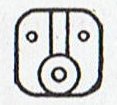
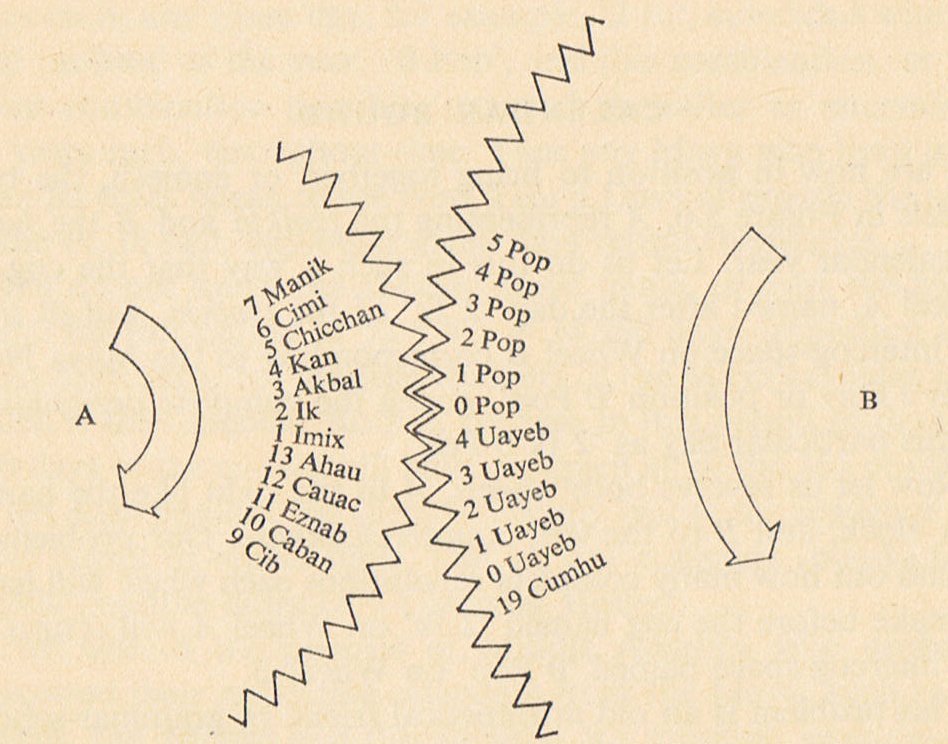
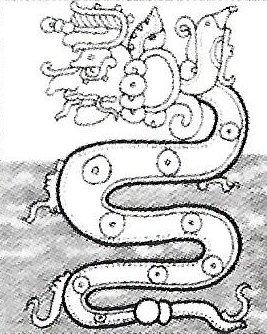
Thirteen
changed to one as each of
these cycles in the Maya
calendar was completed,
therefore, we have the
following sequence:
|
13. |
13. |
13. |
0. |
0. |
0. |
1. |
5
Imix |
9
Kumk'u |
(Aug. 14, 3114
B.C.) |
|
13. |
13. |
13. |
0. |
0. |
1. |
0. |
11 Ahaw |
3
Pop |
(Sept. 2, 3114
B.C.) |
|
13. |
13. |
13. |
0. |
1. |
0. |
0. |
13 Ahaw |
3
Kumk'u |
(Aug.7, 3113
B.C.) |
|
13. |
13. |
13. |
1. |
0. |
0. |
0. |
2
Ahaw |
8
Mak |
(May 1, 3094
B.C.) |
|
13. |
13. |
1. |
0. |
0. |
0. |
0. |
3
Ahaw |
13 Ch'en |
(Nov. 15, 2720
B.C.) |
|
13. |
13. |
13. |
0. |
0. |
0. |
0. |
4
Ahaw |
3
K'ank'in |
(Dec. 23, A.D.
2012) |
|
13. |
1. |
0. |
0. |
0. |
0. |
0. |
10 Ahaw |
13 Yaxk'in |
(Oct. 15, A.D.
4772) |
|
1. |
0. |
0. |
0. |
0. |
0. |
0. |
7
Ahaw |
3
Zotz' |
(Nov. 22, A.D.
154587) |

...
This pot depicts one of
the Hero Twins (One-Ahaw
in the Classic texts and
One-Hunaphu in the
K'iche' Popol Vuh) and a
great bird who is trying
to land in a huge ceiba
tree heavy with fruit.
This mythical bird is
Itzam-Yeh, Classic
prototype of
Wuqub-Kaqix,
'Seven-Macaw', of Popol
Vuh fame. In that story,
in the time before the
sky was lifted up to
make room for the light,
the vainglorious
Seven-Macaw imagined
himself to be the sun.
Offended by his pride,
the Hero Twins humbled
him by breaking his
beautiful shining tooth
with a pellet from their
blowgun. This pot shows
One-Ahaw aiming at the
bird as he swoops down
to land in his tree. As
Itzam-Yeh lands
on his perch, the text
tells us he is 'entering
or becoming the sky'.
This particular
'sky-entering' is not
the one mentioned in the
Palenque text. It is the
final event that
occurred in the previous
creation before the
universe was remade.
Before the sky could be
raised and the real sun
revealed in all its
splendor, the Hero Twins
had to put the false
sun, Itzam-Yeh,
in his place. If the
date on this pot
corresponds to that
pre-Columbian event, as
we believe it does, then
Itzam-Yeh was
defeated on
12.18.4.5.0.1 Ahaw
3 K'ank'in (May
28, 3149 B.C.). After
the new universe was
finally brought into
existence, First Father
also entered the sky by
landing in the tree,
just as Itzam-Yeh
did ...
|
Allen:
"... in Egypt it was Ma'at, the
Vulture-star, when it marked the pole, -
this was 12000 to 11000 B.C. (!), - and
Lockyer, that it was the orientation
point of some of the temples at Denderah
long antecedent to the time when
γ Draconis
and α Ursae Majoris were so used, -
probably 7000 B.C., - one of the oldest
dates claimed by him in connection with
Egyptian temple worship."


|

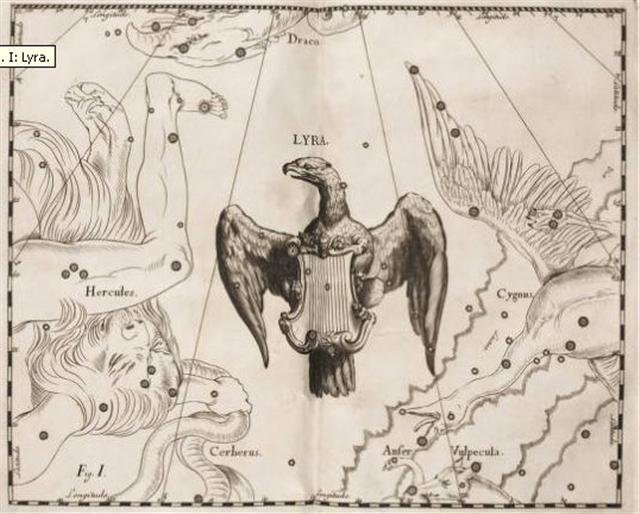


.jpg)









.jpg)





